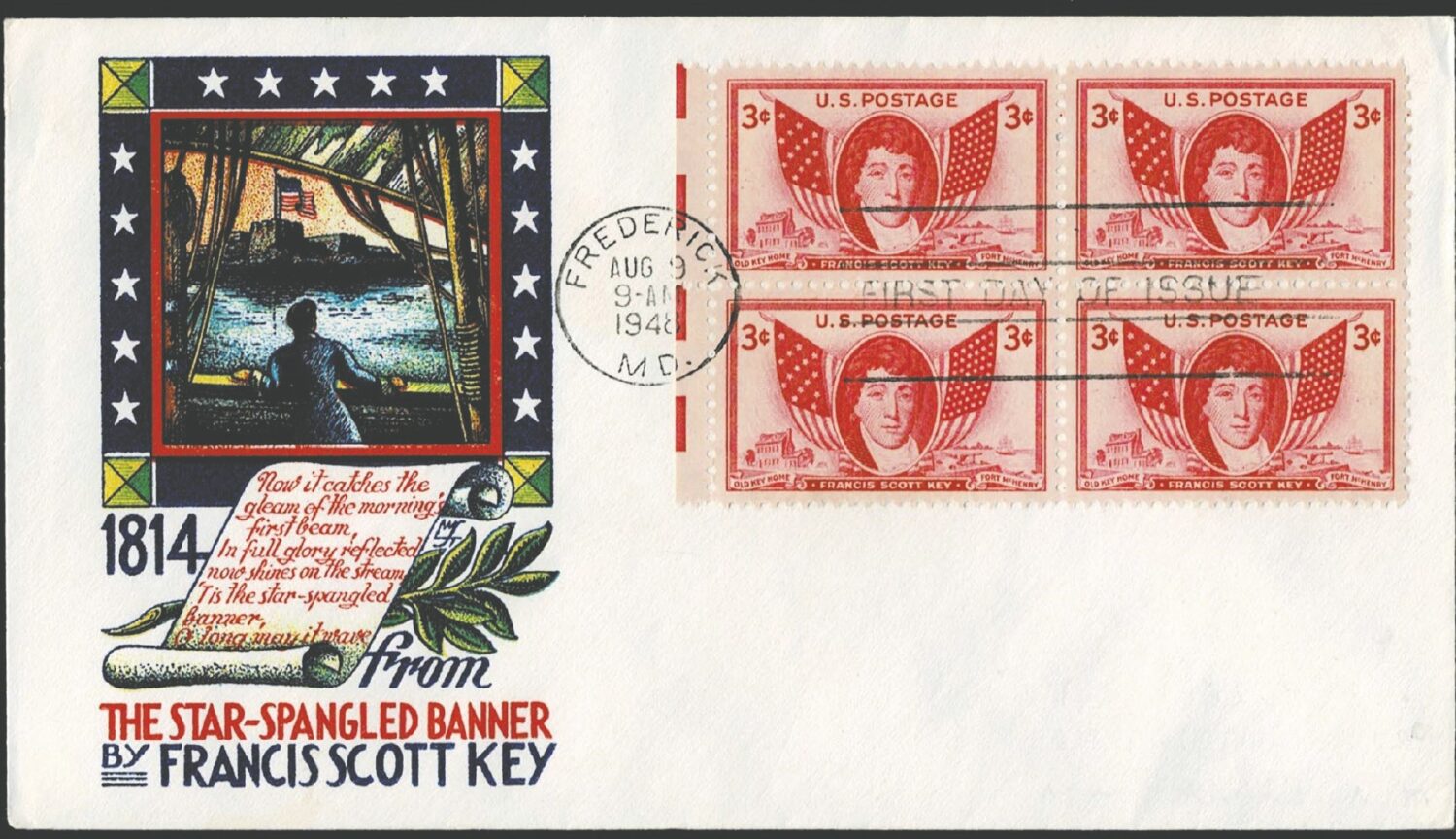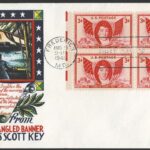Francis Scott Key, 1948
Richard D. L. Fulton

“First Day of Issue” cover of the Francis Scott Key stamp, issued on August 9, 1948, in Frederick.
“O say does that star spangled banner yet wave, O’er the land of the free and the home of the brave…”
~ Defense of Fort McHenry, September 14, Frances Scott Key
lebrated Frances Scott Key, the composer of a poem, the words of which would ultimately become those of the country’s National Anthem, through the issuance of a three-cent stamp.
But nowhere was the issuance of the stamp celebrated more so than in Frederick, the city the United States Post Office designated as the site where the new stamp would be officially released for public sale, Frederick City having been the birthplace of Key on August 1, 1779.
Frances Scott Key was born in Frederick to John Ross Key and Ann Phoebe Dagworthy Charlton Key. The couple had six children, but only three survived into adulthood: Frances Scott Key, Anne Arnold Phoebe Charlton Key, and John Alfred Key, according to findagrave.com.
John Ross Key had served in the Revolutionary War, beginning in 1775, as a second lieutenant in a Maryland rifle company, and subsequently, in 1781, served as the captain of a Frederick County cavalry company.
Key’s son, Francis, would be thrust into his own place in history on September 14, 1814, while being held prisoner by the British during the Battle of Baltimore.
The Battle of Baltimore was initiated by the British in the wake of their invasion of Washington, D.C., and the burning of and setting fire to a number of federal buildings, including the Capitol and the White House on August 24, 1814, during the War of 1812.
Following the British withdrawal, hastened by the appearance of a rare tornado that had passed through the District of Columbia, the enemy focused on attacking Baltimore from land and sea, beginning on September 12.
However, prior to the opening guns at the Battle of Baltimore, Keys joined in an effort to secure the release of William Beanes, a prominent Upper Marlboro physician who had been captured by the British and was being held on a British ship off Baltimore, according to the National Park ServiceKey and a compatriot managed to convince the British to release Beanes, but concerns that Key, a compatriot (Colonel John Skinner), and Beanes had seen too much of the deployment of the British ships, the British refused to allow them to return to Baltimore.
The initially victorious British ground forces suddenly found themselves facing some 10,000 troops, along with 100 cannons, that had arrived in time to check the British troops from advancing any further than the ground they had gained in the process of driving on towards Baltimore.
The stalled British infantry would need help from their navy, and only a sole fort—Fort McHenry—guarding the Port of Baltimore, stood in the way. The British would have to silence the fort to engage the American infantry that had successfully checked the advance of the British troops.
The British navy began opening fire on the fort. During the course of the ensuing 27 hours of siege launched against the fort, the British fired more than 1,500 cannon balls, shells, and rockets at the fort, inflicting only minimal damage, according to battlefields.org.
During the dawn of September 14, the American troops within the fort lowered a smaller “storm flag” and raised a 30-by-42-foot garrison flag, which had permitted Key to see that by dawn’s early light, and the flash of exploding British rockets, that the American flag was still there.
The British failed at driving the defenders of Fort McHenry off, and the land forces and British navy withdrew… opting instead to capture New Orleans, where they met with an even greater and more devastating defeat on January 8, 1815.
Key was released, along with some of his notes he had made in the form of a poem, which he called, “Defense of Fort McHenry.”
Key’s poem was subsequently set to the tune of “To Anacreon in Heaven,” and renamed “The Star-Spangled Banner,” according to battlefields.org. “The Star-Spangled Banner” became the National Anthem of the United States in 1931.


